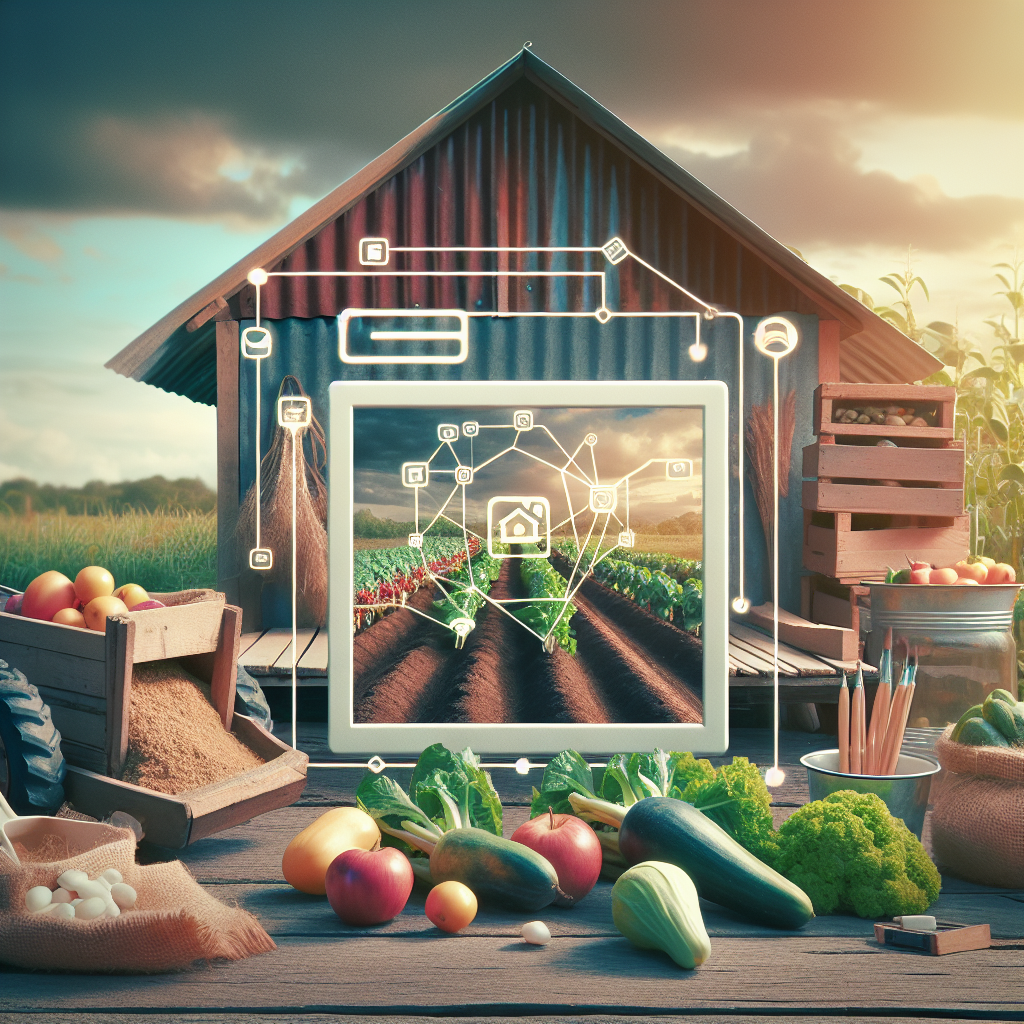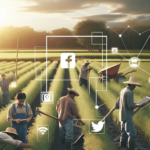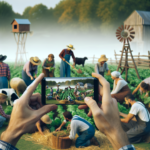An Intro to Social Media in Agriculture
Ever wondered how farming and Facebook could possibly mix?
You’d be surprised!
Nowadays, farmers are leveraging social media platforms to connect with their customers, network with other farmers, and stay up-to-date with agricultural advancements.
Let’s explore this interesting confluence of traditional farming and modern technology, examining the various ways Facebook and other social platforms are being harnessed for agricultural gain. From promoting products and services to creating targeted marketing campaigns, these platforms are adding a dynamic new dimension to farming.
So, let’s get started. We even have some practical steps for setting up your own farm’s Facebook page in the mix!
Exciting, isn’t it?
Table of Contents
Exploring Farmers’ Use of Facebook
Reasons Farmers Are on Facebook
Farmers use Facebook for several reasons. Here’s a quick look at some of the main motivations:
- Connecting with customers
- Networking with other farmers
- Accessing timely agricultural information
- Promoting products and services
- Participating in farming communities
Connecting with Customers
Farmers can use Facebook to connect directly with their customers. This platform allows:
- Sharing updates about farm activities
- Advertising upcoming events
- Posting photos of produce and livestock
- Handling customer queries and feedback
These interactions can help build trust and loyalty.
Networking with Other Farmers
Farmers can benefit from networking with one another on Facebook. They use it to:
- Exchange tips and advice
- Discuss challenges and solutions
- Share equipment and resources
These connections can lead to valuable support systems.
Accessing Timely Agricultural Information
Many agricultural organizations maintain Facebook pages. Farmers use these to stay informed about industry news. For instance, farmers can:
- Get updates on weather forecasts
- Learn about new farming techniques
- Stay informed on regulatory changes
Farmers often follow pages like the official agriculture departments for reliable updates.
Promoting Products and Services
Facebook serves as a platform for farmers to market their products. This includes:
- Creating business pages
- Advertising sales and discounts
- Announcing new products
Engaging posts and ads can attract new customers.
Participating in Farming Communities
Numerous farming groups exist on Facebook. Farmers join these groups to:
- Engage in discussions
- Share experiences
- Seek advice from peers
These communities foster a sense of belonging.
Common Features Used by Farmers
Farmers use a variety of Facebook features to achieve their goals. The most common ones include:
- Facebook Pages
- Groups
- Facebook Marketplace
- Live Streaming
These tools enhance their interactions and outreach.
| Feature | Purpose |
|---|---|
| Facebook Pages | Marketing and customer interaction |
| Groups | Community building and networking |
| Facebook Marketplace | Buying and selling products |
| Live Streaming | Real-time updates and Q&A sessions |
Farmers utilize these features to maximize their reach and efficiency.
Facebook Analytics: Leveraging Data for Farmer Success
Why Facebook Analytics Matters for Farmers
For farmers, using Facebook isn’t just about posting pictures of their latest harvest or sharing cute videos of farm animals. Facebook Analytics can provide important data that can inform their business decisions, such as:
- Identifying peak interaction times
- Understanding post engagement
- Gauging customer demographics
- Evaluating post reach
By analyzing this data, farmers can tailor their content strategy for optimum customer engagement and conversion.
Key Metrics in Facebook Analytics
Facebook provides a wealth of analytics, some of the key metrics that farmers should mindful of include:
- Post Reach: This shows how many users saw a post. Higher reach can indicate persuasive content or effective promotion strategies.
- Engagement: Metrics such as likes, shares, and comments measure how users are interacting with posts. These suggest how well content resonates with the audience.
- Followers: An increase in followers can show growth while a decrease might indicate a need to re-evaluate content or customer service.
Using Facebook Insights
Facebook’s analytics tool, Facebook Insights, can provide valuable performance metrics for farmers’ business pages. Key capabilities are:
- Post performance analysis: Determine how well certain posts perform in comparison to others.
- Understanding audience demographics: Gain insight to tailor content, products, or services to the majority market.
Hyperlocal Marketing through Facebook
What is Hyperlocal Marketing?
Hyperlocal marketing involves targeting prospective customers in a highly specific, geographically restricted area, often focused around a single location or region. For farmers, hyperlocal marketing via Facebook can mean:
- Targeting Facebook ads to users based on geographical location
- Sharing posts about appearances at local farmer’s markets or events
- Promoting local weather conditions applicable to their farming activities
Key Advantages of Hyperlocal Marketing for Farmers
Facebook’s hyperlocal marketing functionalities can provide farmers with specific advantages, such as:
- Increased local engagement: Farmers can foster relationships within their communities and remind customers to support local business.
- Improved targeting efficiency: Money spent on Facebook ads can yield higher returns as they’re focused on a specific, more likely to engage audience.
How to Enable Hyperlocal Marketing on Facebook
Turning on location-based features in Facebook can help farmers with their hyperlocal marketing efforts. Here are some ways to do so:
- Setting the business location on their Facebook page
- Creating geographically targeted Facebook ads
- Tagging their farm’s location in posts
These steps should help farmers make the most of their Facebook presence and tap into their local customer base more effectively. According to Single Grain, an authority in digital marketing, these simple steps can significantly enhance a business’ local reach.
Creating a Facebook Page for Your Farm
Starting a Facebook page for your farm can help you reach a wider audience and engage with customers effectively. Here’s how to get started.
Setting Up Your Facebook Page
To make a Facebook page for your farm, follow these steps:
- Navigate to Facebook’s Create a Page section.
- Select the page type that best fits your farm. Usually, “Business or Brand” is the most appropriate choice.
- Enter your farm’s name and select the appropriate category, such as “Farm” or “Agriculture.”
- Fill out your farm’s contact information, including address, phone number, and website if available.
- Add a profile picture, which should be your farm’s logo or a recognizable image related to your business.
- Upload a cover photo that represents your farm, like a panoramic view of your fields or a close-up of your produce.
Optimizing Your Page
Once you’ve set up your page, optimize it for better engagement and visibility:
- About Section: Fill out the “About” section with a detailed description of your farm. Highlight what makes your farm unique, and include keywords related to your farm’s products and services.
- Call to Action Button: Choose a suitable call-to-action (CTA) button, such as “Shop Now,” “Contact Us,” or “Learn More.” This will guide visitors on what to do next.
- Services and Products: List out the services you offer and the products you sell, along with prices, to make it easy for customers to know what they can buy.
- Regular Updates: Post regularly about farm activities, seasonal produce, and upcoming events. Use high-quality images and engaging captions.
Effective Content Strategies
Content is key to engaging your audience. Consider these content strategies:
| Content Type | Purpose | Example |
|---|---|---|
| Photos and Videos | Visual Attraction | Harvesting scenes, animal care routines |
| Live Streams | Real-Time Engagement | Live Q&A, farm tours |
| Events | Customer Interaction | Farmers’ market schedules, workshops |
| Stories | Timely Updates | Daily farm activities, new arrivals |
Engaging with Your Audience
Engagement helps build a loyal customer base. Here are some practices to enhance interaction:
- Respond to Comments: Timely responses to comments and messages show that you value customer interaction.
- Host Contests: Run contests and giveaways to encourage sharing and tagging, expanding your reach.
- User-Generated Content: Share customer photos and stories that feature your products.
Analyzing Performance with Insights
Monitor your page’s performance using Facebook Insights:
- Track Metrics: Keep an eye on metrics such as reach, engagement, and follower growth to understand what resonates with your audience.
- Improve Based on Data: Use the data to tweak your content strategy, focusing on what works best.
By setting up and optimizing your Facebook farm page, you’ll be well-positioned to engage with customers, promote your products, and build a strong online community. For more detailed guidance on Facebook marketing, Single Grain offers extensive resources and tips.
Promoting Your Farm on Instagram
Why Use Instagram for Farm Promotion?
Instagram offers a highly visual platform that can significantly benefit farmers looking to promote their products and services. Here are some reasons why Instagram is a valuable tool for farm marketing:
- Visual Appeal: Instagram’s emphasis on photos and videos is perfect for showcasing beautiful farm landscapes, fresh produce, and farm life.
- Engagement: Users on Instagram often interact more with content compared to other platforms, making it ideal for building a loyal customer base.
- Hashtags: Effective use of hashtags can vastly improve the discoverability of your posts, reaching new audiences.
- Stories: Instagram Stories allow you to post real-time updates, promotions, and behind-the-scenes looks at your farm, adding a personal touch.
Optimizing Your Instagram Profile
Before posting content, ensure your Instagram profile is fully optimized for maximum engagement:
- Profile Picture: Use a clear, recognizable image such as your farm’s logo or a high-quality photo of your produce.
- Biography: Write a concise bio that explains who you are and what your farm offers. Include relevant keywords and a call to action.
- Contact Information: Ensure your contact buttons (email, phone) are active and your website link is updated.
Types of Content to Post
Diversify your content to keep your audience engaged. Here are some effective content types for promoting your farm on Instagram:
| Content Type | Purpose | Example |
|---|---|---|
| High-Quality Photos | Visual Engagement | Close-ups of fresh produce, farm animals |
| Videos | Interactive Content | Time-lapses of planting, harvesting processes |
| Stories | Timely Updates | Behind-the-scenes looks, daily activities |
| Reels | Short, Engaging Clips | Quick tips, DIY farm projects |
Hashtag Strategy
Hashtags can dramatically increase the reach of your posts. Use a mix of popular and niche hashtags to target your audience effectively:
- Popular Farm Hashtags: Use broad but highly popular tags like #FarmLife, #OrganicFarm, and #FarmersMarket.
- Local Hashtags: Add local tags to connect with people in your region, such as #NYFarmers, #CaliforniaOrganic.
- Specific Products: If you grow specific types of produce, use hashtags related to those items, like #HeirloomTomatoes, #FreshBerries.
Engaging with Your Audience
Interaction with your followers can drive engagement and foster customer loyalty:
- Respond to Comments: Quick responses show that you value your followers, helping to build a loyal community.
- Run Giveaways: Host contests where followers can win fresh produce or farm experiences to increase engagement.
- Collaborate: Partner with local influencers or other farms to reach a broader audience.
Utilizing Twitter for Farm Promotion
Why Use Twitter?
Twitter offers a platform for real-time updates and can connect farmers with a broader community. Here are some benefits of using Twitter for farm promotion:
- News and Updates: Share timely updates about farm activities, product availability, and events.
- Customer Interaction: Engage directly with customers through tweets and direct messages.
- Hashtag Visibility: Similar to Instagram, hashtags on Twitter can significantly increase the reach of your posts.
Setting Up Your Twitter Profile
A well-optimized Twitter profile is critical for making a good first impression:
- Profile Picture: Use your farm’s logo or a photo that represents your farm well.
- Bio: Write a short bio that explains what your farm is about and include relevant keywords.
- Pinned Tweet: Pin an important or popular tweet at the top of your profile for visitors to see first.
Content Strategy on Twitter
Here are some content types that work well on Twitter for promoting your farm:
- Timely Updates: Post real-time updates about your farm’s daily activities, event participation, and product availability.
- Photos and Videos: Visual content can enhance engagement, so share pictures of your produce, animals, and farm events.
- Engage in Conversations: Participate in relevant Twitter chats and hashtags to engage with the farming community and potential customers.
By leveraging these social media strategies across different platforms, farmers can effectively expand their reach, engage with customers, and build a strong online presence. For in-depth Twitter marketing strategies, Hootsuite provides a comprehensive guide tailored to different industries.
Conclusion: Maximizing Social Media Utilization for Farmers
In summary, the use of social media platforms like Facebook, Instagram, and Twitter are invaluable tools for farmers to connect with customers, network with other farmers, and stay informed about agricultural information. Farmers can optimize these platforms for interaction with customers, promote products locally or globally, and have an efficient analytic system to take informed business decisions.
The use of data for farmer success involves understanding post engagement, evaluating post reach, and tailoring content strategy for optimal customer engagement. Hyperlocal marketing plays a significant role in making the most of the farmer’s presence and tapping into their local customer base. Furthermore, setting up and optimizing Facebook and Instagram pages leads to a higher reach and customer engagement, promoting farm products and building a strong online community.
Frequently Asked Questions – FAQs
Why are farmers using social media platforms like Facebook, Instagram, and Twitter?
Farm






